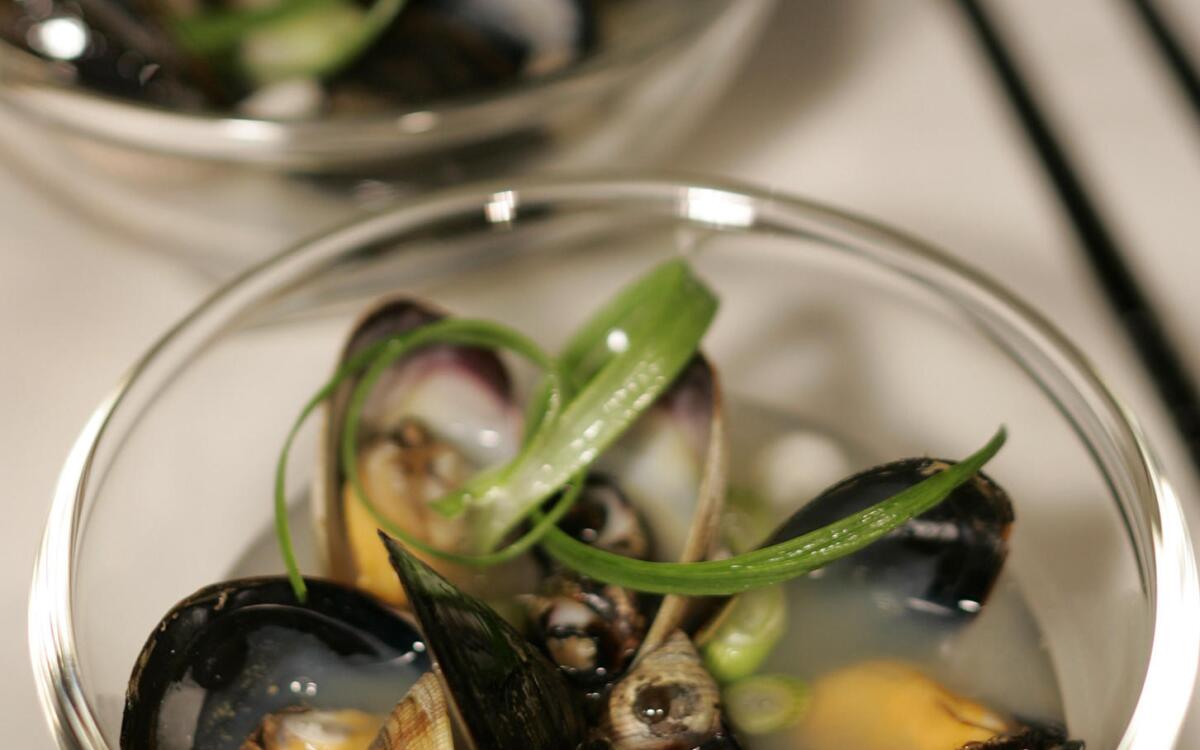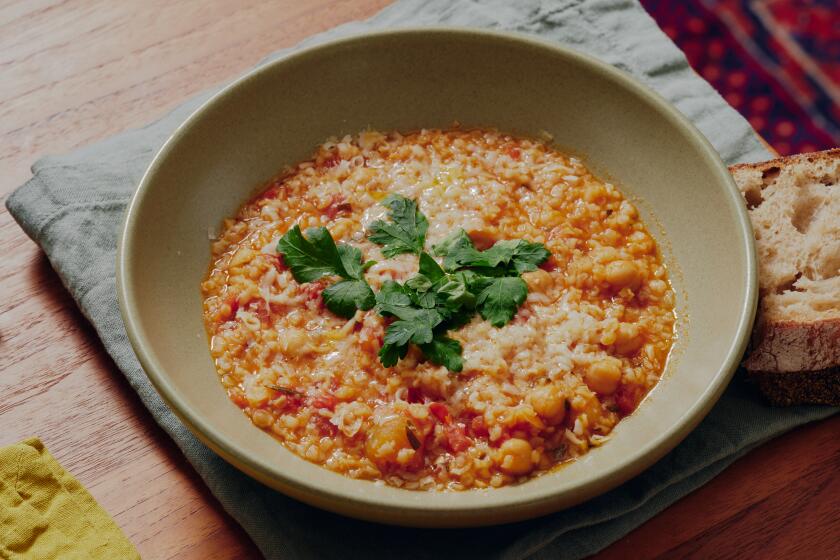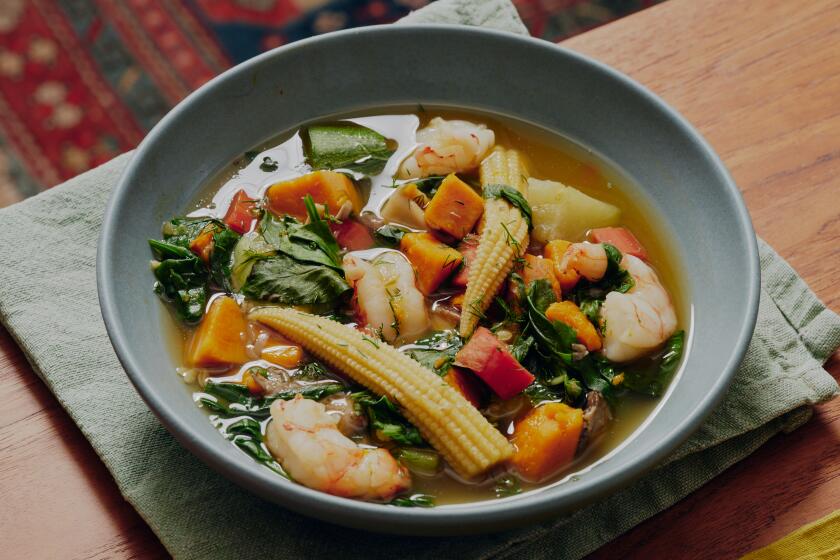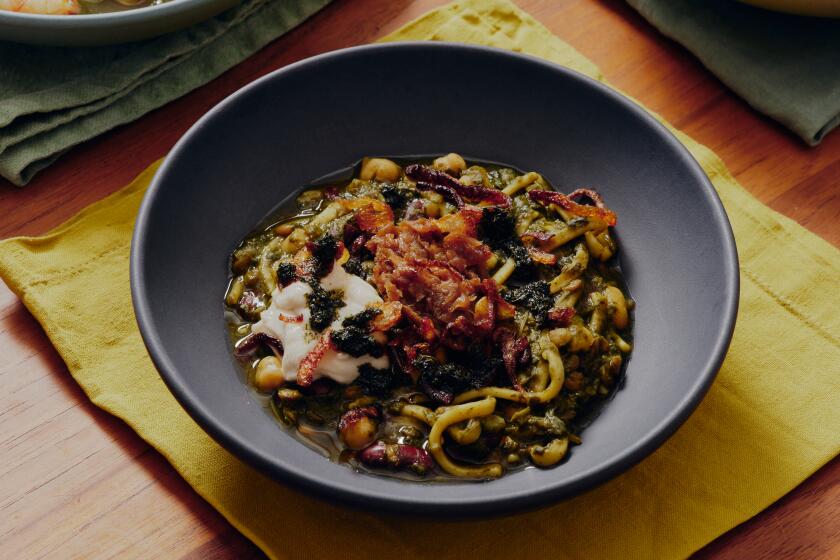Mussels, clams and periwinkles in miso broth

Mussels from Prince Edward Island, cockles from New Zealand, periwinkles from Cape Cod and clams from Vancouver -- the shellfish on our dinner plates have flown in from all over for the occasion.
And we’re glad they did.
You don’t have to put on your clam diggers and head out to the sand when you want a steaming bowl of succulent Manilas or littlenecks these days. Thanks to ongoing advances in shellfish aquaculture, high-qua lity live mollusks are more readily available than ever, year-round.
And the variety and quality is only getting better.
So lately, when you order mussels or clams in a great restaurant, you never know what to expect -- except that it won’t be dull. It’s not just clams with garlic and white wine or moules frites anymore; now mollusks might pick up an Andalusian accent or even Southeast Asian flavors.
Gregg Wangard of Ocean and Vine restaurant in Santa Monica, for example, serves a Thai-inspired dish of Prince Edward Island (PEI) mussels cooked with coconut milk, lime juice and a little chipotle chile for heat. Sweet, slick and succulent, these mussels make a versatile dish, wonderful either as an appetizer or a main course. Wangard serves them with a rustic grilled bruschetta for dipping into the sauce.
On a trip to Spain, Jessica Boncutter, chef at Hog Island Oyster Company in San Francisco, came up with the idea for her Manila clams with chorizo sausage. This is a satisfying turf ‘n’ surf stew of flavors and textures -- toothsome clams, spicy sausage -- that is a perfect light meal with crusty bread and a simple salad. Boncutter often adds cannellini beans and says, “I like to serve this dish tapas style on a small plate drizzled with olive oil.”
Summery menus
When you cook a batch of mussels or even something more unusual -- like cockles or periwinkles -- at home, it’s pure summer ease.
You can dress up mollusks, serving them in pretty dishes with a fine wine, or ladle them out of the pot at the backyard table to enjoy with beer and rustic bread. Either way, they’re fun to eat, a memorable part of a long summer’s evening as you pry meat from shells, savor the briny, chewy bites and dip bread in the fragrant juices and broth.
Mollusks should be purchased live and most should be cooked, if possible, the same day. In L.A.-area seafood markets recently, we found PEI mussels (a variety of blue mussels prized for distinctive flavor and quality), New Zealand green-lipped mussels (also popular, with bright green and yellow shells), black mussels from Maine (tender and less chewy than New Zealand mussels), Manila clams from the Pacific Northwest, periwinkles from Cape Cod and cockles from New Zealand.
To select mussels and other bivalves such as clams and cockles, first tap each shell, which will close if the animal is alive. Discard any that remain open or have damaged shells.
Mussels, essential for paella and bouillabaisse, and delicious steamed, fried or roasted, will keep for a day or two at the most.
They should be stored in the refrigerator in a shallow pan on a rack and covered with a damp cloth until you’re ready to clean them. Do not store them in water or airtight containers. Clams and cockles should be stored in the refrigerator on a large tray or in a bowl covered with a wet newspaper or a damp cloth.
To clean mussels, first grasp the beard (the bundle of fibers near the hinge that looks like sea grass) and remove it with a quick jerk. Scrub the mussels with a brush under running water. They will not live long once they have been debearded and cleaned, so clean them right before cooking.
It’s time to update many old-time clam recipes, because, as Blake Wheeler, fresh seafood buyer at American Fish & Seafood Co. explains, aquaculture clams don’t have the sand and grit of wild clams. If you do pick up clams that have gritty shells, an hour’s immersion in salt water (1 teaspoon per cup water) prior to cooking should be long enough to purge them. When you buy from a dealer who’s kept the mollusks in tanks, they are already purged.
Manila clams and littleneck clams are favorite steamer clams but can also be sauteed, stir-fried, baked or stewed. Cook clams gently to prevent them from becoming tough. There may be a few clams that will open later than the others. To avoid overcooking, remove the opened clams while the unopened clams finish cooking.
Cockles, most often farmed and flown in from New Zealand, are similar in size to Manila clams. They can be recognized by their rounded green and brown shells.
Periwinkles are conical, spiral-shelled univalve mollusks that look like small snails. They are also called sea snails or winkles. Les Twarowski from Los Angeles Fish Co. recommends storing them in the refrigerator covered with a damp cloth or wet newspaper until you’re ready to cook them.
Rinse the shells under water to remove sand and grit before cooking. Periwinkles are very hardy and will keep in the refrigerator up to one week.
To eat them, use a toothpick to gently lift the meat from the shell. As you probe into the shell you will see a thin brown disc (the “trapdoor” that covered the shell’s opening) that can be discarded before pulling out the meat.
Periwinkles add an interesting tender, slightly sweet flavor and texture to the mix of mussels and clams.
After hearing from seafood purveyors that I could easily and economically get not only clams and mussels but also live periwinkles, I couldn’t resist putting them together in a simple and delicious Asian shellfish medley using a miso-broth base.
The slightly salty, earthy flavor of the miso broth is a natural flavor combination with these three mollusks.
And while they might never have been found together in the same tidewater flat or seaside cove, they get along beautifully together in the bowl.
Scrub the clams with a stiff brush under running water to remove all grit. Do not use any open clams or mussels or any with damaged or cracked shells.
To prepare the mussels, remove any stringy “beard” on the outside of the shells and rinse and scrub each shell with a brush under running water to remove grit.
Rinse the periwinkles under running water in a strainer to remove grit, then rinse each shell to remove any clinging dirt.
Pour the water into a large saucepan. Cut or break the dried seaweed into four pieces. Add it to the water and let stand 30 minutes.
Bring the seaweed broth to boil over high heat. Remove the seaweed pieces just before the water begins to boil; discard. When the broth comes to a full boil, stir in the bonito shavings. Cook 30 seconds, then remove from the heat and let it stand, without stirring, until the flakes settle to the bottom, about 10 minutes.
Strain the broth through a cheesecloth-lined strainer. Gather together the ends of the cheesecloth and squeeze out the remaining liquid. Pour the broth back into the saucepan. Place the miso in a small bowl and stir a little broth into it until smooth. Add the thinned miso to the broth. Set aside.
Pour 1 cup water into bottom of a
5-quart pot. Add the clams, mussels and periwinkles. Cover the pot and heat to simmering over medium-high heat. Reduce heat and simmer 5 to 8 minutes, remove the cover and check to see whether they have all opened. Discard any that haven’t.
Heat the miso broth just to a simmer. Divide the shellfish into serving bowls. Strain the cooking liquid through a cheesecloth-lined strainer into the miso broth.
Spoon the broth over the shellfish in the bowls. Thinly slice two of the green onions diagonally and cut thin strips from the green parts of the remaining two green onions and use to garnish each bowl. Serve with small picks for removing the periwinkles from their shells.
Get our Cooking newsletter.
Your roundup of inspiring recipes and kitchen tricks.
You may occasionally receive promotional content from the Los Angeles Times.














